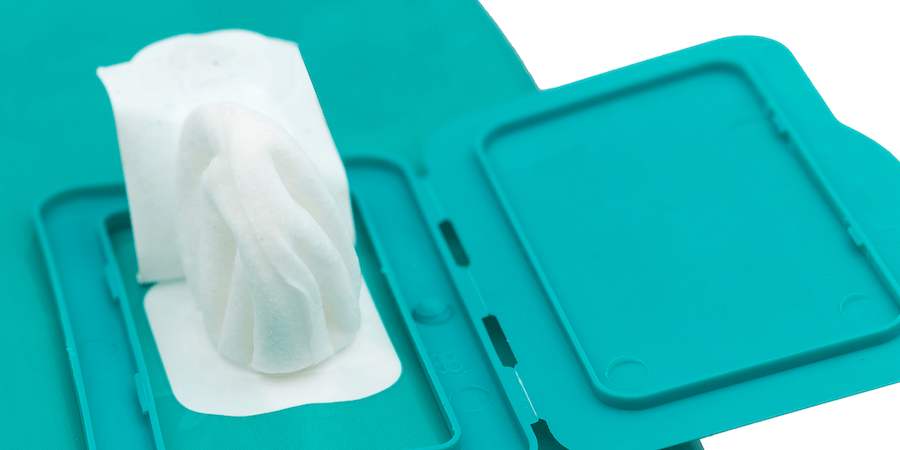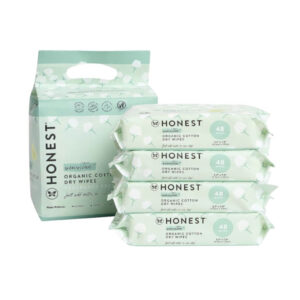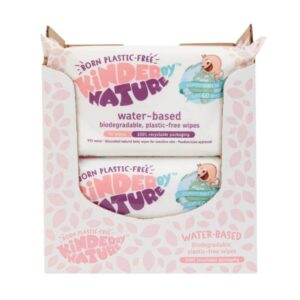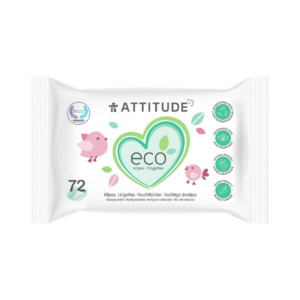We know that caring for your precious little one is your top priority, and that’s why we’re here to help you make informed choices.Baby wipe ingredients stay on your baby’s skin after use, so it’s incredibly important to choose the cleanest options whenever possible (especially since they’re used on very sensitive parts of the body). So, what are the best non-toxic baby wipes? What ingredients and brands should you avoid?
Get ready to discover the best options to keep your bundle of joy clean, happy, and healthy! Keep reading to learn more about non-toxic baby wipes.

Note: This article contains affiliate links, meaning In On Around will make a small commission at no additional cost to you. This helps us maintain the site. As always, we value full transparency & only work with brands we love and trust.
Author: In On Around Founder & CEO, Catherine Power.
- Published On: October 9, 2023
- Updated On: April 26, 2024
Table of Contents
Understanding the Dangers of Conventional Baby Wipes
In our pursuit of providing the best care for our little babes, it’s crucial to be aware of the potential hazards that lurk in everyday products, like conventional baby wipes. These seemingly harmless essentials can harbor a range of toxins that might inadvertently expose our babies to unnecessary risks.
Many conventional baby wipes contain harsh chemicals such as parabens, fragrances, and phthalates. These chemicals have been linked to skin irritations, allergies, and even hormonal disruptions, making it essential for parents to explore safer alternatives.
Infants have very delicate skin that is more permeable and highly sensitive to chemicals.
Fortunately, the market now offers a variety of non-toxic baby wipes made from natural and organic materials. These wipes are free from harmful chemicals, making them a gentle and safer choice for your baby’s skin, while also being more environmentally friendly.

What's In Conventional Baby Wipes?
There’s a wide range of ingredients commonly found in baby wipes… and not all of them are necessarily safe. While companies are required to share the ingredients used to wet the wipes, regulations do not require the disclosure of the cloth materials themselves (polyester, polypropylene, viscose, etc…).
Here’s a list of some potential ingredients commonly found in wipes:
- Formaldehyde, from formaldehyde-releasing preservatives – this is a carcinogen, allergen
- This can be released from ingredients like DMDM hydantoin, Quaternium-15, Polyoxymethylene Urea, and many more.
- To learn more about the potential formaldehyde-releasers, check out the Clean Beauty Checklist E-Book
- Fragrance
- You can learn more about fragrance here: Safe Fragrance 101 – What Is Natural Fragrance?
- Parabens
- You can learn more about parabens here: Paraben Safety – Are Parabens In Makeup Harmful?
- Phthalates – these are endocrine disruptors
- Dyes
- Bleach
- Methylisothiazolinone (MIT)
- Lotion
- PEG ingredients
- Triclosan
- Propylene glycol
- Cocamidopropyl betaine (CAPB)
- Preservatives, like Phenoxyethanol – these are an important component of baby wipes to avoid microbial growth, but some preservatives are safer than others
… and more (this is not an exhaustive list).
Avoid baby wipes with triclosan and those that are marketed to be “antibacterial.”
Hidden Ingredients In Baby Wipes
There are some ingredients that are present in baby wipes but won’t even be on the label, mostly due to contamination.
- Wipe materials (only sometimes disclosed)
- 1,4-dioxane – this is a carcinogenic contaminant that can sometimes be found in certain preservatives, like Polysorbate-20
- Formaldehyde – can be released from ingredients like 2-Bromo-2-Nitropropane-1,3-Diol
- Hydroquinone – certain synthetic forms of Vitamin E, like Tocopheryl Acetate is made with Hydroquinone, which is a potential carcinogen.
Never allow your baby to chew or lick a baby wipe – this can be very dangerous and lead to the ingestion of chemicals.
Choosing the Right Non-Toxic Organic Baby Wipes
When shopping for baby wipes, here’s what to look for…
Materials
- Look for:
- Cotton (ideally 100% organic cotton, those this is rare)
- Wood pulp or viscose
- Bamboo (not my favorite of the options since bamboo processing can be very toxic, but more common and still a better choice than plastics)
- Avoid:
- Petroleum-based plastics, like polyester or polypropylene
- Biodegradable and compostable (they are not the same thing) – Look at how eco-friendly the brand is!
- All compostable items are biodegradable. Not all biodegradable products are compostable.
- To properly biodegrade, they need oxygen, light, and bacteria.
Ingredients
- Free of chlorine (look for chlorine-free cellulose) – although this is rarely disclosed by brands
- Fragrance-free
- This is different than unscented. Unscented means that it can have fragrance ingredients but they’re neutralized or don’t have a smell. We want to avoid fragrance ingredients all-together, so opt for fragrance-free over unscented.
- Your baby’s wipes do NOT need even natural essential oils – they’re completely unnecessary and can be overpowering for their developing bodies.
- Avoid words that start with PEG- and Polysorbate-, as well as words that end in -eth
- Safer preservatives – proper preservation is critical, even if mold or microbial growth is not visible to the eye
- Sodium benzoate – Best option in my opinion
- Make sure it is not combined with citric acid, ascorbic acid, or Vitamin C.
- Potassium sorbate – Second best option
- It’s commonly used alongside Sodium benzoate
- Silver Dihydrogen Citrate – this is a newer preservative that doesn’t have a lot of long-term studies. While initial findings show that it’s non-toxic, I prefer to use caution, especially in baby wipes.
- Avoid these preservatives (many of which are formaldehyde-releasing):
- Silver Dihydrogen Citrate – this is a newer preservative that doesn’t have a lot of long-term studies. While initial findings show that it’s non-toxic, I prefer to use caution, especially in baby wipes.
- Polysorbate 20
- Phenoxyethanol – commonly in “cleaner” greenwashed brands
- Grapefruit seed extract (citrus grandis)
- Parabens
- Methylisothiazolinone
- Diazolidinyl Urea
- DMDM Hydantoin
- Imidazolidinyl Urea
- Quaternium-15
- Sodium Hydroxymethylglycinate
- Glyoxal
- 2-Bromo-2-Nitropropane-1,3-Diol
- Dehydroacetic acid
- Sodium benzoate – Best option in my opinion
Important note: It’s best to trash baby wipes instead of throwing them down the toilet. These can wreak havoc on sewers and home plumbing… even if they’re marketed to be “flushable.” [3]
Due to their high moisture content, baby wipes need a safe preservative otherwise they can be a breeding ground for harmful bacteria or mold.
Should You Buy Hypoallergenic Baby Wipes?
Don’t fall into the “hypoallergenic” marketing. This is not a Federal Department of Agriculture (FDA) regulated term, so there are no federal standards or definitions for hypoallergenic products. Brands can slap “hypoallergenic” on their packaging without having to prove anything.
The same can be said for “Dermatologist Tested” and “Pediatrician Approved.” Disregard these labels.
Best, Better, Worst Baby Wipe Brands
Let’s dive into the best options available!
Best Baby Wipe Brands
These don’t contain plastic materials (like polyester or other petroleum-based cloths) or unnecessary ingredients. It was very difficult to narrow down which brands would be “best” vs. “better” vs. “worse.” My rankings and risk tolerance may be different than yours, so do your own due diligence as well. Take this information and form your own opinion.
The BEST of the best option is to make your own wipes at home for immediate use. If you’re looking for dry wipes, The Honest Company offers organic cotton dry wipes, which are a great choice.
If you’re trying to make your own baby wipes, I’d opt for dry wipes and regularly refresh the wet ingredients to avoid microbial growth (like in a spray bottle that’s regularly cleaned). You can use fresh purified water with a hint of unscented castile soap and/or fractionated coconut oil. Some people also prefer to use paper towels instead of dry wipes, although depending on the brand they can be more abrasive.
* Note: If you make your own wipes, make sure you use them quickly, otherwise, they can breed bacteria and mold (since it won’t have preservatives).
- Material: 100% viscose
- Ingredients: Aqua, Betaine, Levulinic Acid (preservative), Caprylyl/Capryl Glucoside, Potassium Sorbate (preservative), Glycerin, Sodium Levulinate (preservative), Sodium Citrate.
- Pros:
- 100% fragrance-free
- Biodegradable
- 100% recyclable packaging
- Cons:
- Wipes can stick together (since they’re not using plastic or synthetic fibers)
- Betaine can be linked to allergic reactions and dermatitis
- Uses 3 preservatives
- Material: 100% cellulose fiber
- Ingredients: Aqua, Sodium Citrate, Sodium Benzoate (preservative), Potassium Sorbate (preservative), Glycerin, Sodium Cocoamphoacetate, Chamomilla Recutita (Matricaria) Flower Extract, Citric Acid.
- Pros:
- Biodegradable
- Fragrance-free
- EWG-verified
- Cons:
- Contains sodium benzoate and potassium sorbate as a preservative very early in the ingredient list (may be at a higher concentration)
- Material: Certified Organic Cotton (which is very rare!)
- Ingredients: Aqua, Organic Aloe Barbadensis Leaf Juice Powder/Leaf Juice, Sodium Levulinate, Citric Acid, Potassium Sorbate, Sodium Citrate
- Pros:
- EWG-verified
- 100% fragrance-free
- Made with organic ingredients, like organic cotton, which was 100% recycled from the textile industry
- Biodegradable
- They also offer 100% organic GOTS-certified cotton pads (for quick cleanups or makeup removal)
- Cons:
- Uses three preservatives
- Owned by Laboratoires Expanscience
- Material: 100% natural fibers (undisclosed exact kind)
- Ingredients: Water, Gluconolactone, Aloe Barbadensis Leaf Water, Chamomila Recutita Flower Water, Citric Acid, Propanediol, Caprylyl/Capryl Glucoside, Sodium Benzoate (preservative), Calcium Gluconate (preservative), Potassium Sorbate (preservative)
- Pros:
- 100% compostable
- Eco Cert Cosmos Natural certified
- Cons:
- Uses non-organic aloe juice
- Uses three different preservatives
Update February 2024 – A new company called Blissmile has released a 100% water wipe made with 100% cotton. Each wipe is individually packaged and steam sterilized to prevent bacterial growth. This is a great option when traveling or on-the-go!
A lot of brands will showcase their “key ingredients” on their website and not their full ingredient list. Always look for the FULL ingredient list.
Better Baby Wipe Brands
These may use “okay” ingredients and/or use petroleum-based wipe materials.
[10% off discount code inonaround for your first order with diapers]
- Material: 100% cellulose
- Ingredients: Water, Pyrus Malus (Apple) Fruit Extract, Glycerin, Citric Acid, Squalane, Decyl Glucoside, Tocopherol, Sodium Levulinate (preservative), Potassium Sorbate (preservative).
- Pros:
- EWG-verified
- Biodegradable
- Cons:
- Doesn’t claim to be 100% fragrance-free (why they’re in the “okay” section instead of “best”)
- Wipes are only available with a diaper bundle – luckily, they’re at the top of the list for non-toxic diapers! Read more about the best diapers here: The Best Non-Toxic Organic Diaper Brands
- Contains apple extract, which can potentially cause allergies in some babies
- Material: Wood pulp cloth
- Ingredients: Water, Glycerin, Betaine, Gluconolactone (preservative), Sodium Benzoate (preservative), Honey (Manuka), Chamomile Recutita (Matricaria) Flower Extract, Sorbitan Oleate Decylglucoside Crosspolymer, Citrus Grandis (Grapefruit) Extract, Cocos Nucifera (Coconut) Oil, Sodium Citrate
- Pros:
- EWG-verified
- Made with organic coconut oil
- Biodegradable
- Cons:
- Doesn’t claim to be 100% fragrance-free
- Coconut oil can be comedogenic or can clog pores
- Some reports that customers received expired wipes from their Amazon shop
- Gluconolactone isn’t as common of a preservative
- Material: Undisclosed
- Ingredients: Water, Sodium Benzoate, Tetrasodium Glutamate Diacetate, Disodium Cocoamphodiacetate, Decyl Glucoside, Citric Acid, Sodium Citrate, Aloe Barbadensis Leaf Juice, Tocopheryl Acetate, Chamomilla Recutita (Matricaria) Flower Extract, Calendula Officinalis Flower Extract
- Pros:
- Fragrance-free
- Cons:
- Doesn’t use organic ingredients for their aloe
- Doesn’t claim to be biodegradable or compostable – likely made with plastics
- Sodium benzoate is the second ingredient (which means it’s at a higher concentration)
- Material: Undisclosed non-woven fabric
- Ingredients: Water, Glycerin, Aloe Barbadensis Leaf Juice, Lactobacillus/Arundinaria Gigantea Ferment Filtrate, Lavandula Angustifolia (Lavender) Oil, Argania Spinosa Kernel Oil, Sorbitan Oleate Decylglucoside Crosspolymer, Tocopherol, Gluconic Acid, Citric Acid, Sodium Benzoate (preservative), Potassium Sorbate (preservative)
- Pros:
- EWG-verified
- Fragrance-free
- NSF Organic Standard certified and made with 70% certified organic ingredients
- Cons:
- Uses both sodium benzoate and potassium sorbate
- Contains added oils which can be allergens, like lavender oil
- Material: 100% FSC-certified plant fibers
- Ingredients: Water (Aqua), Organic Aloe Vera (Aloe barbadensis) Leaf Juice, Glycerin, Levulinic Acid, Sodium Levulinate, Sodium Benzoate, Disodium Cocoamphodiacetate, Potassium Sorbate, Sodium Chloride.
- Pros:
- 100% biodegradable
- 100% fragrance-free
- EWG-verified
- Available at Walmart
- Cons:
- Uses four different preservatives
- Material: Unbleached bamboo
- Ingredients: Water, Polyhexamethylene Biguanide HCL (preservative), Sodium Benzoate (preservative), Decyl Glucoside, Ethylhexylglycerin, Hydroxyacetophenone, Gluconolactone (preservative), Citric Acid, Aloe Barbadensis Leaf Extract, Chamomile Recutita Extract, Cucumis Sativus (Cucumber) Fruit Extract, Silicone Antifoam Emulsion
- Pros:
- Fragrance-free
- EWG-verified
- 100% biodegradable
- Cons:
- Doesn’t use organic ingredients for their aloe
- Difficult to find the full ingredient list on their website
- Uses a high concentration of multiple preservatives
- Has additives that can cause allergic reactions in some babies, like ethylhexylglycerin
- Material: 100% FSC-certified viscose
- Ingredients: Purified Water, Organic Aloe Barbadensis Leaf Juice Powder, Organic Simmondsia Chinensis (Jojoba) Seed Oil, Chamomilla Recutita (Matricaria) Flower Extract, Silver Dihydrogen Citrate (preservative), Non-GMO Citric Acid, Decyl Glucoside, Sodium Citrate.
- Pros:
- Fragrance-free
- Biodegradable
- Cons:
Support brands that are fully transparent with the materials they use.
- Material: 100% plant-based fibers
- Ingredients: Water, Squalane, Glycerin, Decyl Glucoside, Pyrus Malus (Apple) Fruit Extract, Tocopherol (Vitamin E), Sodium Levulinate, Citric Acid, Potassium Sorbate
- Pros:
- FSC-certified cloth fibers
- EWG-verified
- Cons:
- Infused with squalane, which isn’t a necessary ingredient in baby wipes
- Many reviews report that the wipes have a strong odor
- Doesn’t claim to be 100% fragrance-free
- Material: Spunlace (cellulose and synthetic blend)
- Ingredients: Reverse Osmosis Water, Glycerin, Potassium Sorbate (preservative), Aloe Barbadensis Leaf Extract, Xylitol, Citric Acid, Alkyl Polyglucoside
- Pros:
- Uses reverse osmosis purified water
- Cons:
- Claims to be unscented, not 100% fragrance-free
- Material: Viscose
- Ingredients: Water, Trisodium Ethylenediamine Disuccinate, Sodium Benzoate (preservative), Sorbitan Oleate Decylglucoside Crosspolymer, Caprylyl Glycol (preservative), Ethylhexylglycerin (preservative), Citric Acid
- Pros:
- EWG-verified
- Compostable in 8 weeks (when used under home composting conditions)
- Cons:
- Contains three different preservatives, two of which aren’t as commonly used and can cause allergic reactions, like Ethylhexylglycerin
- Material: Polyester and viscose
- Ingredients: Purified Water, Glyceryl Oleate Citrate, Caprylic/capric Triglyceride, Decyl Glucoside, Organic Olea Europaea (Olive) Oil, Persea Gratissima (Avocado) Oil, Organic Chamomile Recutita (Matricaria) Lower Extract, Organic Calendula Oicinalis Lower Extract, Organic Aloe Barbadensis Extract, Solanum Lycopersicum (Tomato) Seed Oil, Organic Helianthus Annuus (Sunlower) Seed Oil, Vaccinium Macrocarpon (Cranberry) Seed Oil, Organic Nigella Sativa (Black Cumin) Seed Oil, Rubus Idaeus (Raspberry) Seed Oil, Citric Acid, Sodium Benzoate, Potassium Sorbate
- Pros:
- Fragrance-free
- Cons:
- Uses both sodium benzoate and potassium sorbate
- Includes a lot of ingredients that aren’t necessary, like different seed oils which can potentially cause allergic reactions
- Material: Undisclosed, but “plant-based”
- Ingredients: Water, Gluconolactone (preservative), Sodium Benzoate (preservative), Hydroxyacetophenone, Organic Aloe Vera Extract, Organic Chamomile Extract, Decyl Glucoside, Polyaminopropyl Biguanide (preservative), Ethylhexylglycerin.
- Pros:
- Fragrance-free
- Uses organic extracts
- Cons:
While I’m not a fan of grapefruit seed extract and it does contain trace amounts of Benzalkonium Chloride (around 0.002%), I do love how simple the ingredient list is. For this reason, I’ve ranked it at the bottom of the “better” category instead of the worst. This certainly wouldn’t be my first choice.
- Material: 100% viscose
- Ingredients: 99.9% purified water, 0.1% grapefruit seed extract with trace amounts of Benzalkonium Chloride
- Pros:
- Only two ingredients
- Cons:
- Uses grapefruit seed extract (GSE), which contains traces of Benzalkonium Chloride. GSE may contain parabens, among other synthetic compounds. [9]
- Many reports on Amazon that the wipes have a strong smell
- Uses grapefruit seed extract (GSE), which contains traces of Benzalkonium Chloride. GSE may contain parabens, among other synthetic compounds. [9]

Worst Baby Wipe Brands
These brands have poor-quality preservatives, contain phenoxyethanol or other low-quality ingredients that don’t meet my standards. Many of these are *still* much better options than the conventional wipes that are full of fragrance.
- Material: Plant-based fibers, including VEOCEL lyocell
- Ingredients: Purified water, Tocopherol acetate, Decyl Glucoside, Glycerin, Sodium Benzoate, Hydroxyacetophenone, Citric Acid, Silicone Quaternium-17, Laureth-9
- Pros:
- EWG-verified
- Cons:
- Contains silicone quaternium-18, laureth-9. This is known as a “quat” which can release formaldehyde.
- Material: Bamboo
- Ingredients: Water, Glycerin, Chamomilla Recutita Flower Extract, Tocopheryl Acetate, Aloe Barbadensis Extract, Decyl Glucoside, Benzethonium Chloride, Citric Acid.
- Pros:
- Can send wipes to a centralized processing center with their Redyper program
- Cons:
- Uses Benzethonium Chloride which is a synthetic quaternary ammonium salt
- Claim to be unscented, not 100% fragrance-free
- Doesn’t use organic ingredients
- Material: 100% organic cotton (which is rare!)
- Ingredients: Aqua, Brassica Campestris Seed Oil (Rapeseed), Glycerin, Lauryl Glucoside, Polyglyceryl-2-dipolyhydroxystearate, Prunus Armeniaca Kernel Oil (Apricot), Levulinic Acid, Parfum (Citrus Dulcis Extract (Orange), Amyris Balsamifera Bark Oil, Coriandrum Sativum Fruit Oil (Coriander), Juniperus Virginiana (Red Cedar), Citrus Bergamia Peel Oil Expressed (Bergamot Orange), Citrus Amara (Bitter Orange), Piper Nigrum Oil (Black Pepper), Sodium Levulinate, Sodium Chloride, Chamomilla Recutita Flower Extract (Chamomile), Maltodextrin, Prunus Amygdalus Dulcis Oil (Sweet Almond), Tocopherol (Vitamin E), Helianthus Annuus Seed Oil (Sunflower), Potassium Sorbate, Glyceryl Oleate, Dicapryl Carbonate, Sodium Phytate, Limonene, Linalool
- Pros:
- EWG-verified
- Biodegradable
- Made with 100% organic cotton
- Cons:
- Contains parfum (although it’s from natural essential oils) – this is completely unnecessary and can cause allergic reactions.
- They have a very, very long ingredient list
- Material: 100% bamboo fiber
- Ingredients: Purified New Zealand Water, Japanese Soybean Amino Acid, New Zealand Certified Organic Aloe Vera Extract, German Chamomile Essential Oil and Vitamin E.
- Pros:
- Biodegrades in 3 weeks
- Uses organic extracts
- Cons:
- Japanese Soybean Amino Acid typically has preservatives, like potassium sorbate and sodium benzoate. The label does not detail what preservatives are used, so it’s best to skip. This wouldn’t be in compliance with other country standards.
A better option compared to Pampers Sensitive, but still not the best option.
- Material: Mix of polyester, cellulose, and organic cotton
- Ingredients: Water, Citric Acid, PEG-40 Hydrogenated Castor Oil, Sodium Citrate, Sorbitan Caprylate (preservative), Sodium Benzoate (preservative), Disodium EDTA
- Pros:
- Water is purified via reverse osmosis
- Fragrance-free
- Cons:
- Owned by Procter & Gamble
- Uses PEG-40 Hydrogenated Castor Oil, which is an ethoxylated ingredient that can potentially contain ethylene oxide
- Material: Polypropylene
- Ingredients: Water, Glycerin, Benzyl Alcohol, Sodium Cocoyl Hydrolyzed Soy Protein, Oryza Sativa (Rice) Extract, Potassium Sorbate, Benzoic Acid, Aloe Barbadensis Leaf Extract, Dehydroacetic Acid, Citric Acid, Tocopheryl Acetate
- Pros:
- Available in-store at Whole Foods
- Cons:
- Uses both benzoic acid (similar to sodium benzoate), potassium sorbate, and dehydroacetic acid for preservation. Dehydroacetic acid shouldn’t be used in products around the mouth (like baby wipes) since it can be toxic. [10]
- Contains soy protein, which some babies may be sensitive to
- Contains alcohol, which can be drying
7 - HealthyBaby
- Material: Undisclosed
- Ingredients: Purified Water, Organic Aloe Barbadensis Leaf Juice, Chamomilla Recutita, Lonicera Caprifolium (Honeysuckle) Flower Extract, Lonicera Japonica (Honeysuckle) Flower Extract, Glycerin, Tocopherol, Gluconic Acid, Sodium Benzoate, Citric Acid
- Pros:
- Fragrance-free
- EWG-verified
- MADE SAFE certified
- Biodegradable within a landfill in 365 days
- Uses organic aloe
- They offer wet wipes AND dry wipes (so you can use your own solution or water)
- Cons:
- I prefer to avoid Japanese honeysuckle extract since it may mimic parabens. I talk about this more in my Clean Beauty Checklist E-Book.
8 – Aleva Naturals Bamboo Baby Wipes
- Material: Bamboo
- Ingredients: Water, Glycerin, Potassium Sorbate, Organic Chamomilla Recutita (Matricaria) Flower Oil, Organic Camellia Sinensis Tea Leaf Extract, Didecyldimonium Chloride, Cocamidopropyl Betaine, Lauralkonium Chloride, PEG 40 Hydrogenated Castor Oil, Citric Acid, Organic Aloe Barbadensis Leaf Juice Powder, Lavandula Angustifolia (Lavender) Oil, Citrus Medica Limonium (Lemon) Peel Oil, Melaleuca Alternifolia (Tea Tree) Leaf Oil
- Pros:
- Uses some organic ingredients
- Cons:
- Contains ingredients like PEGs, cocamidopropyl betaine, didecyldimonium chloride, and more.
- Not fragrance-free
9 – Kirkland Fragrance Free Baby Wipes
- Material: Wood pulp
- Ingredients: Water, Coco Glucoside, Xanthan Gum, Glyceryl Oleate, Phenoxyethanol (preservative), Sodium Benzoate (preservative), Tetrasodium Glutamate Diacetate, Citric Acid, Sodium Citrate
- Pros:
- Available at Costco
- Fragrance-free
- Cons:
- Uses phenoxyethanol
- There’s an ongoing class action lawsuit against their marketing practices for biodegradable labeling [11]
10 – Mama Bear
- Material: Undisclosed
- Ingredients: Water, Phenoxyethanol (preservative), Decyl Glucoside, Tetrasodium Glutamate Diacetate, Sodium Benzoate, Sodium Citrate, Citric Acid, Sodium Bicarbonate, Glycerin, Tocopheryl Acetate, Cucumis (Sativus) Cucumber Fruit Extract, Calendula Officinalis Flower Extract, Glycyrrhiza Glabra (Licorice) Root Extract, Chamomilla Recutita (Matricaria) Flower Extract, Aloe Barbadensis Leaf Extract
- Pros:
- Fragrance-free
- Cons:
- Uses phenoxyethanol at higher concentrations
- Contains unnecessary extracts that may cause an allergic reaction
11 – Pampers Sensitive
- Material: Undisclosed
- Ingredients: Water/Eau, Citric Acid, PEG-40 Hydrogenated Castor Oil, Sodium Citrate, Sorbitan Caprylate (preservative), Sodium Benzoate (preservative), Disodium EDTA, Bis-PEG/PPG-16/16 PEG/16 Dimethicone, Capryl/Caprictriglycerine, Xanthan Gum.
- Pros:
- Water is purified via reverse osmosis
- Fragrance-free
- Cons:
- Owned by Procter & Gamble
- Uses PEG-40 Hydrogenated Castor Oil, which is an ethoxylated ingredient that can potentially contain ethylene oxide
- Contains other potentially harmful ingredients like Bis-PEG/PPG-16/16 PEG/16 Dimethicone
12 – Seventh Generation
- Material: Blend of wood fiber, polypropylene, and polyethylene
- Ingredients: Water, Cocamidopropyl pg-dimonium chloride phosphate, Citric acid, Quillaja saponaria wood extract, Aloe barbadensis leaf extract, Tocopheryl acetate, Sodium benzoate
- Pros:
- Fragrance-free
- Cons:
- Owned by Unilever
- Whitened with Elemental Chlorine Free bleaching process (not TCF)
13 – Burt’s Bees Baby Wipes Sensitive
- Material: Undisclosed – likely polyester
- Ingredients: Water, Glycerin, Aloe Barbadensis Leaf Juice, Helianthus Annuus (Sunflower) Seed Oil, Tocopherol, Citric Acid, Sodium Benzoate, Potassium Sorbate, Sodium Cocoyl Glutamate, Disodium Cocoyl Glutamate, Phenoxyethanol
- Pros:
- Fragrance-free
- Cons:
- Includes phenoxyethanol
- Not biodegradable
- Owned by The Clorox Company
All of your conventional wipe brands, like Huggies, Pampers, Mustela, Up & Up (and many more) would fall into the worst of the worst category. Amazon Elements Fragrance-Free wipes and Bloom Baby wipes also fall into this category.
Final Thoughts – Non-Toxic Baby Wipes
Prioritizing non-toxic baby wipes isn’t just a choice for the health-conscious parent; it’s a decision that resonates with creating a safer, more nurturing environment for our children. By understanding the potential dangers of conventional wipes, we empower ourselves to make informed choices that contribute to the overall well-being of our precious little ones.
⬇ Pin this “Non-toxic Baby Wipes?” pic on Pinterest for future reference! ⬇

Frequently Asked Questions – Non-Toxic Wipes
Click on the below FAQs to learn more about natural baby wipes, organic baby wipes, chemical-free baby wipes, gentle baby wipes and non-irritating, sensitive, green, and clean wipes free of toxins.
No,hypoallergenic is not a Federal Department of Agriculture (FDA) regulated term, so there are no federal standards or definitions for hypoallergenic products.
It’s important to consider all materials and ingredients used in the baby wipes, especially the type of preservatives.
Plant-based baby wipes are a better option for babies and the environment. They use materials like cotton, viscose, and bamboo, instead of petroleum-derived plastics.
Yes, fragrance in baby wipes is completed unnecessary and should be avoided. Opt for 100% fragrance-free instead.
What are your favorite baby wipe brands?
Let me know your thoughts and key takeaways in the comments below!
You can watch our web story here.
xoxo,

Want to read more? Check out my other articles here!
Other references on Non-Toxic Baby Wipes: EWG, Gimme The Good Stuff, The Atlantic, The Honest Consumer, Proud Happy Mama, Have Twins First, The Mummy Bubble, Green Active Family, Gentle Nursery, FDA, Force of Nature, I Read Labels For You, Safe Mama, Hello Natural Living, Campaign for Safe Cosmetics, European Commission, Hello Natural Living, Raising Toxin Free Children, Better Goods,
Copyright In On Around LLC 2023 ©. The statements made on this website have not been evaluated by the FDA (U.S. Food & Drug Administration). They are not intended to diagnose, treat, cure, or prevent any disease. The information provided by this website should not be used as individual medical advice and you should always consult your doctor for individual recommendations and treatment. The information contained in this site is provided on an “as is” basis. Related to this site, there are no guarantees of completeness, accuracy, usefulness, or timeliness. In On Around LLC assumes no responsibility or liability for any errors or omissions in the content of this site.








